

Game Tools : Values At Play. Design Methodology – The VAP design methodology is described in several research papers located on this site.

VAP Quick Reference vapquickref.pdf Grow-A-Game Cards Now available for iPhone and iPad! Tiltfactor is delighted to be able to share some design methods with the public. » Become More Creative With These 5 Brainstorming Hacks » Farshid Palad. Rolestorming - Brainstorming Techniques from MindTools. Improving Group Brainstorming Generate ideas using someone else's perspective. © iStockphoto/Elnur Have you ever been in a brainstorming session and had a good idea that was a little "out there"?

If so, you might have kept the idea to yourself, because you felt embarrassed about sharing it with your group. After all, if the idea was too far-fetched or different, it might damage your reputation, right? However, you may have felt more comfortable sharing your ideas if they were "someone else's. " This is where Rolestorming is useful. This simple brainstorming technique encourages group members to take on other people's identities while brainstorming. About the Tool.
Game Design Process 101: Part II (Creative Thinking) For many people who want to be Game Designers, the most difficult thing about the process, aside from the actual work, follows soon after the initial spark of inspiration strikes.
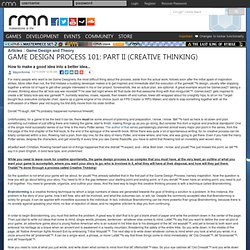
More often than not, the first mistake a budding developer makes is to get inspired and immediate start the execution of the game’s design, usually after slapping together a whole lot of hype to get other people interested in his or her project. Screenshots, like an actual plan, are optional. A great example would be GamerJoe21 taking a shower, thinking about the ‘kick-ass war movie’ he saw last night where ‘that dude did that awesome thing with that minigun’. Don’t laugh, it’s probably happened numerous times… Unfortunately, for a game to be the best it can be, there must be some amount of planning and preparation. €œBut wait! So the question is not what your game will be about, for you’ve already satisfied that in the first part of the Game Design Process, namely inspiration. Whew. 1001 Game Ideas Package. Creativity Techniques in Game Design. Six Thinking Hats. Six Thinking Hats is a book by Edward de Bono which describes a tool for group discussion and individual thinking involving six colored hats.
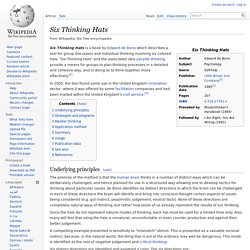
"Six Thinking Hats" and the associated idea parallel thinking provide a means for groups to plan thinking processes in a detailed and cohesive way, and in doing so to think together more effectively.[2] Underlying principles[edit] The premise of the method is that the human brain thinks in a number of distinct ways which can be deliberately challenged, and hence planned for use in a structured way allowing one to develop tactics for thinking about particular issues. de Bono identifies six distinct directions in which the brain can be challenged. In each of these directions the brain will identify and bring into conscious thought certain aspects of issues being considered (e.g. gut instinct, pessimistic judgement, neutral facts). Since the hats do not represent natural modes of thinking, each hat must be used for a limited time only. Visualizing the Creative Process. As I coach new developers, I've taken to scribbling out the same useful diagram for visualizing the creative process again and again on coffee-ringed napkins.
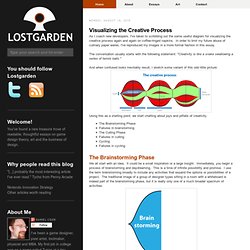
In order to limit my future abuse of culinary paper wares, I've reproduced my images in a more formal fashion in this essay. The conversation usually starts with the following statement: "Creativity is like a snake swallowing a series of tennis balls. " And when confused looks inevitably result, I sketch some variant of this odd little picture: Brainstorming. Description: Brainstorming is the name I have chosen to use to describe techniques aimed at generating new ideas (e.g. game concepts, features, game mechanics, play mechanics, etc.) or solving design problems (e.g. imbalances, loopholes, control schemes, etc.) through spontaneity.
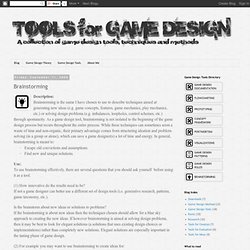
Features - Jumpstarting Your Creativity. [Experienced sound designer Brad Meyer (DJ Hero) espouses a creative philosophy of taking a step back and making common sense decisions as the best method for reinvigorating that elusive creative spark once it's fled.]
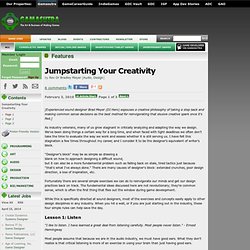
As industry veterans, many of us grow stagnant in critically analyzing and adapting the way we design. We've been doing things a certain way for a long time, and when faced with tight deadlines we often don't take the time to evaluate the way we work and assess whether it is still serving us. I have felt this stagnation a few times throughout my career, and I consider it to be the designer's equivalent of writer's block. Creativity/Innovation. Casual Game Design » Coming up with game ideas. How to Design and Playtest Your Game Concepts « Game-Based Learning Dev. Notice: I’ve written the next iteration of this blog post: How to Design and Playtest Your Games (version 2.0).
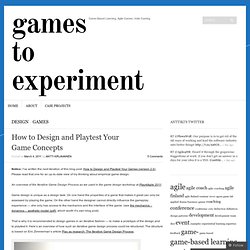
Please read that one for an up-to-date view of my thinking about empirical game design. An overview of the Iterative Game Design Process as we used in the game design workshop at Play4Agile 2011. Game design is unique as a design task. On one hand the properties of a game that makes it great can only be assessed by playing the game. On the other hand the designer cannot directly influence the gameplay experience — she only has access to the mechanics and the interface of the game.
That is why it is recommended to design games in an iterative fashion — to make a prototype of the design and to playtest it. The Puzzle Machine by Profound Whatever, on Flickr (CC non-commercial, attribution, share-alike) 1. The first step is to decide what are you going to design the game for. Objectives andConstraints. David Perry on Game Design: A Brainstorming Toolbox - Game Worlds.